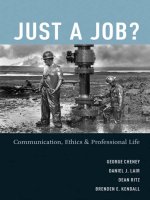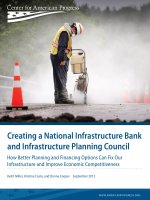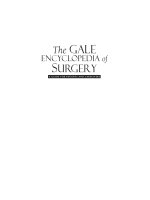A RAND INFRASTRUCTURE, SAFETY, AND ENVIRONMENT PROGRAM Transportation, Space, and Technology pot
Bạn đang xem bản rút gọn của tài liệu. Xem và tải ngay bản đầy đủ của tài liệu tại đây (1.45 MB, 73 trang )
This document and trademark(s) contained herein are protected by law as indicated in a notice appearing later in
this work. This electronic representation of RAND intellectual property is provided for non-commercial use only.
Unauthorized posting of RAND PDFs to a non-RAND Web site is prohibited. RAND PDFs are protected under
copyright law. Permission is required from RAND to reproduce, or reuse in another form, any of our research
documents for commercial use. For information on reprint and linking permissions, please see RAND Permissions.
Limited Electronic Distribution Rights
This PDF document was made available from www.rand.org as a public
service of the RAND Corporation.
6
Jump down to document
THE ARTS
CHILD POLICY
CIVIL JUSTICE
EDUCATION
ENERGY AND ENVIRONMENT
HEALTH AND HEALTH CARE
INTERNATIONAL AFFAIRS
NATIONAL SECURITY
POPULATION AND AGING
PUBLIC SAFETY
SCIENCE AND TECHNOLOGY
SUBSTANCE ABUSE
TERRORISM AND
HOMELAND SECURITY
TRANSPORTATION AND
INFRASTRUCTURE
WORKFORCE AND WORKPLACE
The RAND Corporation is a nonprofit research
organization providing objective analysis and effective
solutions that address the challenges facing the public
and private sectors around the world.
Visit RAND at www.rand.org
Explore the RAND Transportation, Space, and Technology Program
View document details
For More Information
A RAND INFRASTRUCTURE, SAFETY, AND ENVIRONMENT PROGRAM
Transportation, Space, and Technology
Purchase this document
Browse Books & Publications
Make a charitable contribution
Support RAND
This product is part of the RAND Corporation monograph series. RAND mono-
graphs present major research findings that address the challenges facing the public
and private sectors. All RAND monographs undergo rigorous peer review to ensure
high standards for research quality and objectivity.
China
Emerging Technology Opportunities for the Tianjin Binhai New Area (TBNA)
and the Tianjin Economic-Technological Development Area (TEDA)
A RAND INFRASTRUCTURE, SAFETY, AND ENVIRONMENT PROGRAM
Transportation, Space, and Technology
Sponsored by the Tianjin Binhai New Area and the
Tianjin Economic-Technological Development Area
EXECUTIVE SUMMARY
The
Global Technology
Revolution
Richard Silberglitt • Anny Wong
with
S. R. Bohandy • Brian G. Chow • Noreen Clancy • Scott Hassell
David R. Howell
• Gregory S. Jones • Eric Landree • Parry Norling
The RAND Corporation is a nonprofit research organization providing objective analysis
and effective solutions that address the challenges facing the public and private sectors
around the world. RAND’s publications do not necessarily reflect the opinions of its
research clients and sponsors.
R
®
is a registered trademark.
© Copyright 2009 RAND Corporation
Permission is given to duplicate this document for personal use only, as long as it is unaltered
and complete. Copies may not be duplicated for commercial purposes. Unauthorized
posting of R AND documents to a non-RAND Web site is prohibited. R AND
documents are protected under copyright law. For information on reprint and linking
permissions, please visit the RAND permissions page (
permissions.html).
Published 2009 by the RAND Corporation
1776 Main Street, P.O. Box 2138, Santa Monica, CA 90407-2138
1200 South Hayes Street, Arlington, VA 22202-5050
4570 Fifth Avenue, Suite 600, Pittsburgh, PA 15213-2665
RAND URL:
To order RAND documents or to obtain additional information, contact
Distribution Services: Telephone: (310) 451-7002;
Fax: (310) 451-6915; Email:
This study was sponsored by the Tianjin Binhai New Area (TBNA) and the Tianjin
Economic-Technological Development Area (TEDA) and was conducted under the
auspices of the Transportation, Space, and Technology (TST) Program within RAND
Infrastructure, Safety, and Environment (ISE).
Library of Congress Cataloging-in-Publication Data
The global technology revolution, China, executive summary : emerging technology opportunities for the
Tianjin Binhai new area (TBNA) and the Tianjin economic-technological development area (TEDA) /
Richard Silberglitt [et al.].
p. cm.
Includes bibliographical references.
ISBN 978-0-8330-4648-2 (pbk. : alk. paper)
1. Research, Industrial—China—Tianjin. 2. Technological innovations—China—Tianjin. 3. Economic
development—China—Tianjin. 4. Technology and state—China—Tianjin. 5. Binhai Xinqu (Tianjin, China)
I. Silberglitt, R. S. (Richard S.) II. Rand Corporation.
T177.C5G585 2009
338'.0640951154— dc22
2009001377
iii
Preface
In 2007, the Tianjin Binhai New Area (TBNA) and one of its administrative zones—the
Tianjin Economic-Technological Development Area (TEDA)—in northeast China asked
the RAND Corporation to perform a technology-foresight study to help them develop and
implement a strategic vision and plan for economic growth through technological innovation.
is book describes the results of that study. e principal objectives were (1) to identify the
most-promising emerging technology applications (TAs) for TBNA and TEDA to pursue as
part of their plan for growth, (2) to analyze the drivers and barriers they would face in each
case, and (3) to recommend action plans for each TA. For a more detailed discussion of the
material described in this book, including further documentation and references, the reader
is strongly recommended to review the in-depth analyses from this study (see Silberglitt and
Wong, 2009).
In performing this study, RAND staff met with representatives of the communities of
TBNA and TEDA stakeholders, both in China and in the United States. We also collected
data both on site and by reviewing relevant international literature. Our methods, as well
as additional data and analyses, were built on the foundation of the 2006 RAND report,
e Global Technology Revolution 2020, Executive Summary: Bio/Nano/Materials/Informa-
tion Trends, Drivers, Barriers, and Social Implications (GTR 2020 Executive Summary) and
e Global Technology Revolution 2020, In-Depth Analyses: Bio/Nano/Materials/Information
Trends, Drivers, Barriers, and Social Implications (GTR 2020 In-Depth Analyses) (together,
GTR 2020).
is book should be of interest to executives, managers, planners, businesspersons, sci-
entists, engineers, and residents of TBNA, TEDA, and other communities in China and the
developing world more broadly. It should also be of interest to the international development
community, as well as academic, government, and private-sector organizations and individuals
interested in emerging-technology development, application, and implementation.
The RAND Transportation, Space, and Technology Program
is research was conducted under the auspices of the Transportation, Space, and Technology
(TST) Program within RAND Infrastructure, Safety and Environment (ISE). e mission of
RAND Infrastructure, Safety, and Environment is to improve the development, operation,
use, and protection of society’s essential physical assets and natural resources and to enhance
the related social assets of safety and security of individuals in transit and in their workplaces
and communities. e TST research portfolio encompasses policy areas including transporta-
iv The Global Technology Revolution China, Executive Summary
tion systems, space exploration, information and telecommunication technologies, nano- and
biotechnologies, and other aspects of science and technology policy.
Questions or comments about this report should be sent to the project leader, Richard
Silberglitt (). Information about the TST Program is available
online ( Inquiries about TST research should be sent to the fol-
lowing address:
Martin Wachs, Director
Transportation, Space, and Technology Program, ISE
RAND Corporation
1776 Main Street
P.O. Box 2138
Santa Monica, CA 90401-2138
310-393-0411, x7720
v
Contents
Preface iii
Summary
vii
Acknowledgments
ix
Abbreviations
xi
CHAPTER ONE
Introduction 1
A Vision of the Future for TBNA and TEDA
1
Achieving the Vision for TBNA and TEDA rough Foresight Analysis
2
An Overview of the Most-Promising Technology Applications for TBNA and How We
Selected em
3
e Foundation for TBNA’s Future Development in Science and Technology
4
TBNA and TEDA’s Mission as a Special Pilot Zone for Economic and Environmental
Development
4
China’s Pressing National Needs
5
Drivers and Barriers to Technological Innovation in China and TBNA
6
Capacity Currently Available to TBNA and TEDA
7
CHAPTER TWO
A Close Look at the Seven Most-Promising Technology Applications 9
Cheap Solar Energy
9
Available Capacity
9
Drivers and Barriers
10
Recommended Strategy
10
Advanced Mobile Communications and Radio-Frequency Identification
10
Available Capacity
11
Drivers and Barriers
11
Recommended Strategy
11
Rapid Bioassays
11
Available Capacity
11
Drivers and Barriers
12
Recommended Strategy
12
Membranes, Filters, and Catalysts for Water Purification
12
Available Capacity
12
Drivers and Barriers
13
Recommended Strategy
13
vi The Global Technology Revolution China, Executive Summary
Molecular-Scale Drug Design, Development, and Delivery 13
Available Capacity
13
Drivers and Barriers
13
Recommended Strategy
14
Electric and Hybrid Vehicles
14
Available Capacity
14
Drivers and Barriers
15
Recommended Strategy
15
Green Manufacturing
15
Available Capacity
15
Drivers and Barriers
16
Recommended Strategy
16
CHAPTER THREE
Building for TBNA’s Future: Integrating the Seven Action Plans into an Overarching
Strategic Plan
17
Develop State-of-the-Art R&D Capacity in Relevant Areas
17
Update and Expand the Existing Manufacturing Base
18
Build Capacity for S&T Commercialization
18
Selected Bibliography
19
vii
Summary
is book summarizes the results of a study performed for the Tianjin Binhai New area
(TBNA) and the Tianjin Economic-Technological Development Area (TEDA) within the
municipality of Tianjin in northeast China. In 2006, China’s State Council gave TBNA a
mandate to become the country’s next regional engine for economic growth, as well as a center
for leading-edge research and development (R&D) and technology innovation and modern
manufacturing. TEDA, established in 1984, is TBNA’s industrial and manufacturing base.
To support their strategic planning for economic development through technological
innovation, TBNA and TEDA managers asked RAND to conduct a foresight study to iden-
tify promising technology applications (TAs), identify capacity needs to implement these TAs,
develop a strategy and action plan for each TA, and provide guidance concerning the inclusion
of these TAs into their overarching strategic plan.
is book describes the selected TAs, the process used to select them, and each TA’s capac-
ity needs, drivers, barriers, and suggested implementation strategy. It also discusses their inclu-
sion into an overarching strategic plan. e detailed action plans for each TA are described in
the full report of the study (Silberglitt and Wong, 2009).
ix
Acknowledgments
e authors greatly appreciate the hospitality provided by the many members of the TBNA and
TEDA communities who met with us during our visits to China, as well as their willingness to
share with us their thoughts, experiences, and data and other information that were essential
for our analyses. We are also extremely grateful to the TBNA and TEDA senior managers who
met with us both in China and the United States; Mu Dan Ping, who provided us with an
important perspective on the history and issues currently facing TBNA and TEDA; Qian Gu,
Jianhui Hu, Xiaoyan Li, Xiao Wang, Xin Wang, Mengjie Wu, Shinyi Wu, and Henu Zhao for
their invaluable assistance with Chinese translations; Yong Kang for his help in arranging an
important set of meetings at Tsinghua University; Matthew Southerland for essential research
into the English and Chinese literature; and our colleagues Susan Everingham, Julie Kim,
Debra Knopman, and Martin Wachs for their sage advice and guidance. We also thank Lisa
Spear for her expert administrative support in the development of this book.
We owe a special debt of gratitude to our peer reviewers, Steven Berner, William Blan-
pied, and Carl Dahlman, whose insightful analyses and suggestions provided the impetus for
significant revisions and improvements to this book.
xi
Abbreviations
CAS Chinese Academy of Sciences
CATARC China Automotive Technology and Research Center
CNANE China National Academy of Nanotechnology and Engineering
EPA U.S. Environmental Protection Agency
EU European Union
GDP gross domestic product
GMP good manufacturing practice
IC internal combustion
IPR intellectual property rights
ISE RAND Infrastructure, Safety and Environment
km kilometer
NIBC Nanotechnology Industrial Base Company
NVCC Nanotechnology Venture Capital Company
PV photovoltaic
R&D research and development
RFID radio-frequency identification
S&E science and engineering
S&T science and technology
sq km square kilometer
TA technology application
TBC Tianjin Biochip Corporation
TBNA Tianjin Binhai New Area
TEDA Tianjin Economic-Technological Development Area
xii The Global Technology Revolution China, Executive Summary
TST Transportation, Space, and Technology
TU Tianjin University
1
CHAPTER ONE
Introduction
Running along 150 kilometers (km) of coastline in the sprawling municipality of Tianjin
in northeast China,
1
Tianjin Binhai New Area (TBNA) has taken on a pivotal role in Chi-
na’s national economic strategy. Tianjin municipal authorities first established this locality
of approximately 2,200 square km (sq km) in 1994. At that time an arid, undeveloped area,
TBNA was given the ambitious task of spurring industrial growth in Tianjin. In little more
than a decade, it has become home to 1.4 million people, northern China’s largest container
port, and a broad base of industry and manufacturing.
In 2006, China’s State Council named this industrial center in the municipality of Tian-
jin as a “special pilot zone” with a mandate to become the country’s next regional engine for
economic growth. In this capacity, it is to serve as a model of regional development and eco-
nomic reform for other parts of China. Now reporting directly to the State Council, TBNA
benefits from a host of favorable national-government policies and tax incentives designed to
attract foreign and domestic investment and stimulate trade. It is expected to emerge as China’s
next economic powerhouse, invigorating the economy of the northeastern Bohai Rim region in
the same manner as Shanghai and Suzhou did in the Yangtze River delta area and Guangzhou
and Shenzhen in the Pearl River delta area before it.
e Tianjin Economic-Technological Development Area (TEDA) is one of three admin-
istrative zones in TBNA. It is also TBNA’s industrial and manufacturing base and the center
of TBNA’s financial and commercial activities. TEDA is to play a key part in the economic
growth envisioned for TBNA. Established in 1984, TEDA is today a bustling industrial-park
complex. It possesses a robust manufacturing base, with pillar industries in electronics, auto-
mobiles and parts, food processing, and biopharmaceuticals. Many of the world’s Fortune
500 companies, top Chinese firms, and other leading multinationals have strong presences in
TEDA.
A Vision of the Future for TBNA and TEDA
In its directive, the State Council specified that TBNA focus its development efforts in three
domains, eventually becoming a center in north China for the following three spheres:
leading-edge research and development (R&D) and technology incubation•
1
A municipality in China is not a city in the Western sense of the term but rather an expansive administrative unit that
extends from a populous urban core to cover a very large surrounding region. ere are only four such municipalities in
China, each of which holds the status of province and reports directly to the Chinese central government.
2 The Global Technology Revolution China, Executive Summary
first-class, modern manufacturing•
international shipping and logistics.•
At the same time, along with economic development, the State Council intends for TBNA
to lead efforts to address many of China’s most urgent national problems. Steadily rising energy
demands, a growing scarcity of usable water supplies, and gravely escalating urban pollution
are among China’s greatest concerns. With these needs in mind, TBNA, as a pilot zone, is to
present an alternative to the traditional industrial economy, shaping a model of sustainable
development and ecofriendly industry that will contribute to tackling all of these challenges.
Innovation in science and technology (S&T) stands at the core of this vision of economic
and environmental development, particularly of cutting-edge R&D. TBNA will need to take
definitive steps to pursue this goal, and TEDA will be at the forefront of this effort. Building
on its existing manufacturing base, TEDA aims to transition from a successful industrial-park
complex into a state-of-the-art science and engineering (S&E) center for high-impact emerging
technologies. Other enterprises with relevant capacity located elsewhere in TBNA will follow
suit. e desired end result is innovative R&D that meets international standards and posi-
tions TBNA as a global technology leader.
Achieving the Vision for TBNA and TEDA Through Foresight Analysis
Early in the process of developing a strategic plan for this ambitious transformation, senior
managers from TBNA and TEDA found a 2006 report by the RAND Corporation, e Global
Technology Revolution 2020, Executive Summary: Bio/Nano/Materials/Information Trends,
Drivers, Barriers, and Social Implications (GTR 2020 Executive Summary) and e Global
Technology Revolution 2020, In-Depth Analyses: Bio/Nano/Materials/Information Trends, Driv-
ers, Barriers, and Social Implications (GTR 2020 In-Depth Analyses) (together, GTR 2020).
is pair of reports is a comprehensive foresight analysis that identifies technology applications
(TAs) most plausible by 2020, those countries capable of acquiring them, and their likely
effects on society. e study focused on the applications made possible by emerging technol-
ogy trends rather than on the technologies themselves because technologies on their own rarely
deliver solutions to real-world problems. Instead, solutions derive from the ways in which tech-
nologies are put to beneficial use. Accordingly, GTR 2020 highlights TAs, such as cheap solar
energy, instead of technologies, such as photovoltaic (PV) materials.
Having reviewed GTR 2020, TBNA and TEDA managers approached RAND to con-
duct a foresight study designed specifically for their purposes. ey commissioned RAND to
do the following:
Identify promising emerging TAs for TEDA and other high-tech centers in TBNA to •
implement as a pivotal part of TBNA’s overall strategic plan for economic growth.
Identify the capacity needs to implement these TAs, as well as the critical drivers and bar-•
riers that might facilitate or hinder implementation.
Develop a strategy and action plan for each TA.•
2
2
In this summary, we describe the strategy for each TA. e detailed action plans can be found in the chapters on the
individual TAs in Part Two of the companion report (Silberglitt and Wong, 2009).
Introduction 3
Provide guidance on how these TAs might fit into an overarching strategic plan for •
TBNA’s economic development.
An Overview of the Most-Promising Technology Applications for TBNA and
How We Selected Them
Seven innovative TAs emerged from our analysis as particularly promising for TBNA to pursue
as it endeavors to fulfill the State Council’s mandate:
cheap solar energy:• solar-energy systems inexpensive enough to be widely available to devel-
oping and undeveloped countries, as well as disadvantaged populations
3
advanced mobile communications and radio-frequency identification (RFID)•
4
: multi-
functional platforms for sensing, processing, storing, and communicating multiple types
of data
rapid bioassays: • tests to quickly detect the presence or absence of specific biological sub-
stances with multiple simultaneous tests possible
membranes, fabrics, and catalysts for water purification: • novel materials to desalinate, dis-
infect, decontaminate, and help ensure the quality of water with high reliability
molecular-scale drug design, development, and delivery: • the abilities to design, develop, and
deliver drug therapies at the nanoscale to attack specific tumors or pathogens without
harming healthy tissues and cells and to enhance diagnostics
electric and hybrid vehicles: • automobiles available to the mass market with power systems
that combine internal combustion (IC) and other power sources
green manufacturing: • the development and use of manufacturing processes that minimize
waste and environmental pollution and optimize the use and reuse of resources.
To arrive at this selection, we began with the 12 TAs identified in GTR 2020 as those
that China could acquire by 2020. We then combined this with a rigorous study of realities,
circumstances, and issues in TBNA and in China more broadly, drawing on a diverse array of
Chinese- and English-language sources:
Chinese- and English-language documents describing the mission, history, and current •
status of TBNA and TEDA
Chinese- and English-language literature on China’s social, environmental, and economic •
needs and measures that the Chinese government has taken to date to address them
on-site interviews that we conducted in TBNA, TEDA, Tianjin Port, the municipality of •
Tianjin more broadly, and the city of Beijing
visits to S&T institutions that could provide capacity outside TBNA and TEDA, such as •
Tsinghua University and the Chinese Academy of Sciences (CAS)
a two-day workshop that we held in TEDA with key figures from TEDA scientific insti-•
tutions, firms, and management.
3
is and the following definitions are based on those used in GTR 2020.
4
RFID involves technologies that can store and wirelessly transmit information over short distances.
4 The Global Technology Revolution China, Executive Summary
On the basis of that analysis, we narrowed down the top 12 TAs for China to the final
selection of seven. ese either come directly from GTR 2020 or are hybrids combining one
or more of the top 12.
The Foundation for TBNA’s Future Development in Science and Technology
e analysis on which we based our selection of TAs and, eventually, the strategies and action
plans that we suggested for them, took into account four principal factors:
TBNA and TEDA’s missions, as mandated by China’s State Council•
China’s pressing national needs•
drivers and barriers to technological innovation in China as a whole and for TBNA more •
specifically
relevant capacity currently available to TBNA and TEDA both locally and more broadly •
in R&D, manufacturing, and S&T commercialization.
TBNA and TEDA’s Mission as a Special Pilot Zone for Economic and Environmental
Development
In a relatively short time, TBNA and TEDA have successfully established a strong manufac-
turing base. With its three-pronged mandate for TBNA, the State Council is now calling for
TBNA and TEDA to build on this base to develop a modern, high-tech manufacturing capac-
ity that emphasizes R&D to produce goods that add value and create better-paying jobs. is
type of manufacturing is knowledge-based; consequently, S&T will be a crucial part of this
transformation. e capacity for S&T commercialization will also be vital so that the products
that TBNA and TEDA design in their R&D efforts are highly marketable and can be manu-
factured using innovative production processes.
e part of the State Council’s mandate that directs TBNA to become a center for inter-
national shipping and logistics is closely integrated with R&D and manufacturing objectives.
Achieving this goal will require TBNA to operationalize cutting-edge supply-chain and logis-
tics technologies emerging from current R&D.
A companion mandate for TBNA to experiment with reforms to the financial sector has
helped identify preferred business areas for S&T development. In December 2007, TBNA
signed an agreement with the China Development Bank to co-finance a RMB 2 billion
(US$293 million) venture-capital fund to boost high-tech start-ups in TBNA.
5
is specifies
favored areas for investment: electronics, bioengineering, new materials, new energy, environ-
mental protection, and automated manufacturing.
e State Council’s directive to TBNA to implement innovative environmental initia-
tives alongside economic development stems from the recognition that three decades of rapid
economic growth have taken a grave toll on the environment in China. While economic devel-
opment must continue, it must be sustainable. TBNA has already taken definitive first steps
to meet the environmental directive with such initiatives as its circular economy and the Sino-
5
As of November 5, 2008, the exchange rate was 0.146445 U.S. dollars per Yuan. RMB is Renminbi, the official Chinese
currency, which is also frequently referred to as Yuan.
Introduction 5
Singapore Tianjin Eco-City.
6
e first involves using and regenerating resources in sustained
cycles that minimize industrial waste and pollution. e ecocity, with a planned population of
350,000, will be constructed and operate using advanced green technologies, guided by Sin-
gapore’s experience with renewable energy, green manufacturing, low-pollution public trans-
portation, and recycling of water and waste. ese efforts are only the beginning of a push
from TBNA to create a showcase of sustainable development and environmentally friendly
manufacturing approaches. What TBNA successfully prototypes could eventually be put into
use throughout China.
China’s Pressing National Needs
Even as China’s economy continues to grow and its rising middle class enjoys the higher stan-
dard of living that accompanies that growth, the country faces serious challenges:
Reduce rural poverty: • China’s meteoric economic growth has dramatically decreased pov-
erty in busy urban commercial areas. But poverty remains entrenched in much of rural
China. e country needs TAs that can help create opportunities for rural dwellers,
improve their standards of living, and reduce the pressure to migrate to urban centers for
work.
Provide for a large and rapidly aging population: • Despite having curbed its population
growth, China still has more than 1 billion residents, many of whom are elderly. At the
same time, China is transitioning to a new social-welfare system that calls on working-age
people to shoulder much of the cost of providing previously state-funded services. Conse-
quently, TAs that help provide well-paying jobs are essential, as are medical innovations
to help meet the special health requirements of senior citizens.
Meet the population’s health and sanitation needs: • A population as large as China’s presents
daunting health-care needs. Noncommunicable diseases are now the primary concern,
although certain communicable diseases remain a problem. e health-care burden is
disproportionately high in rural areas. China needs TAs that can improve private and
public health care and cost-effectively enhance the quality of water and sanitation, par-
ticularly in rural areas.
Meet growing energy demands: • China is one of the world’s top energy consumers, and its
needs are on a steady upward curve. Oil and gas for automobiles are in particularly high
demand as ever-larger numbers of China’s expanding middle class purchase cars. e
country needs TAs that can tap alternative energy sources, reduce demand for oil, boost
energy efficiency, and decrease industrial energy requirements.
Reverse water shortages: • Clean water is scarce in China overall. Shortages are especially
severe in the north of the country, which suffers from very low rainfall and dwindling
groundwater sources. Yet, residential and industrial demand shows no signs of abating,
and supplies cannot keep pace. TAs that can provide access to clean water from a variety
of sources are vital.
Reduce pollution: • China’s economic boom has left it facing critical pollution levels. Acid
rain, air pollution, urban sprawl, loss of arable land, and red tides are among the grav-
est problems. e country needs TAs that can help balance economic development with
6
A circular economy uses energy, water, and raw materials in sustained cycles to minimize waste and pollution.
6 The Global Technology Revolution China, Executive Summary
environmental protection by reducing toxins in automotive and industrial emissions,
recycling resources, and increasing energy efficiency.
Sustain high economic growth: • China must continue to build and expand its economy to
be able to solve national problems, create jobs, and enhance quality of life for its residents.
e country is now at a crossroads at which knowledge-driven economic growth is criti-
cal to its future. At the core of this growth will be TAs that help China reduce its reliance
on foreign technology sources, join the ranks of the world’s leading S&T nations, and
repair a national brand image damaged by a series of high-profile incidents indicating
poor quality assurance.
Drivers and Barriers to Technological Innovation in China and TBNA
Widespread, sustainable implementation of any TA depends on the balance between the driv-
ers that facilitate implementation and the barriers that hinder it. A single factor can be a driver
or a barrier. Consider cost and financing: e availability of ample venture capital can make
money a driver, but lack of funds can turn it into a barrier.
In our view, the factors that will most influence China’s ability to successfully pursue
cutting-edge R&D and technology innovation are as follows:
the country’s needs•
its national R&D policies•
other national policies that could generate demand (or, as appropriate, reduce demand) •
for certain TAs
intellectual property rights (IPR) protection•
finance and banking laws and regulations•
local policies, laws, and regulations that could directly affect the ability of individuals and •
organizations to conduct cutting-edge R&D and commercialize innovative technologies
human capital•
culture of R&D and innovation.•
ese same eight factors will most affect TBNA’s ability to develop and implement the
selected TAs. Some of these are clearly either a driver or a barrier throughout most of China.
But occasionally, local circumstances make them stronger or weaker drivers or barriers in a
particular organization or region (or for a specific TA) than they are elsewhere in the country.
Several of these factors are unmistakable barriers in TBNA and hold for all seven TAs.
IPR protection, for example, remains a barrier in TBNA, as in China as a whole, to both
homegrown innovation and the involvement of foreign capital and talent in new R&D and
technology ventures. Finance and banking laws and regulations are also a barrier in TBNA,
as they are in China generally, because they discourage investment of venture capital. But, for
certain of the seven TAs, sources of venture capital available to TBNA for specific technologies
mitigate this barrier to some degree. Lack of a culture of R&D and innovation is a third bar-
rier in TBNA, as it is in China as a whole. It discourages the risk-taking in new ventures that
is essential to pursuing and commercializing groundbreaking R&D.
TBNA has one driver that all seven TAs share: human capital. is stems from the
strength of TBNA’s current manufacturing base, the corresponding workforce, and the con-
centration of academic institutions in the municipality of Tianjin. However, young Chinese
Introduction 7
people are tending to shy away from technical and vocational training, and domestic competi-
tion for S&E talent is heated. Both of these could be mitigating factors.
Capacity Currently Available to TBNA and TEDA
To fulfill the State Council’s mandate, TBNA and TEDA will need capacity in three areas:
(1) R&D, (2) manufacturing, and (3) S&T commercialization. Both local capacity—in TBNA,
TEDA, and the municipality of Tianjin more broadly—and that from elsewhere in China and
internationally will play a part.
In terms of R&D capacity, TBNA and TEDA have a growing number of institutions
that provide cutting-edge research facilities and a professional cadre of highly trained scientists
and engineers. But they face intense competition, both within China and abroad, for human
capital of this caliber.
With regard to manufacturing capacity, TBNA and TEDA have a substantial industrial
base that has been growing for the nearly 25 years since TEDA’s inception. Investment by an
array of Fortune 500 companies, a track record of increasing industrial output, and a rising
gross domestic product (GDP) indicate the strength of this base. TBNA is also steadily improv-
ing the physical infrastructure—utilities, cargo facilities, and waste-management processes—
that are vital to manufacturing capacity. But a potential shortage of the skilled laborers and
technicians needed to work in manufacturing and, again, heightened competition for those on
the job market are real challenges.
As for S&T commercialization, TBNA and TEDA operate a well-established network
of research parks and technology incubators aimed at supporting emerging high-tech enter-
prises. Ample financial incentives help spur development and attract human capital. Yet, these
enterprises face considerable challenges due to China’s need to better protect IPR and reform
finance and banking laws and policies. ey also lack strong linkages between R&D institu-
tions and commercial industry to facilitate the transfer of high-tech products to market.
9
CHAPTER TWO
A Close Look at the Seven Most-Promising Technology
Applications
e seven TAs that appear to be most potentially fruitful for TBNA build on two highly influ-
ential emerging global trends in technology and industry. e first is micro- and nanoscale
technology. e vast majority of the TAs identified in GTR 2020 involve advances in micro- or
nanoscale technology and the integration of bio-, nano-, information, and materials technol-
ogy. Similarly, six of the TAs recommended for TBNA involve technologies in this domain.
Second, both industry and consumers today are moving clearly in the direction of green pro-
cesses and technologies. Four of the TAs recommended for TBNA are focused on using energy,
water, and other resources much more efficiently than has occurred in the past.
Cheap Solar Energy
Cheap solar energy has strong potential worldwide market demand. Driven by govern-
ment incentives and renewable-energy subsidies—especially in Germany and Japan—the
solar-electricity industry has grown at an average annual rate of 44 percent over the past five
years. In 2007, it grew by 55 percent to nearly $13 billion. To sustain such growth, companies
are now competing to make solar-energy systems less expensive and more efficient.
China needs to promote energy growth but, concurrently, to develop renewable-energy
sources, improve air quality, and reduce pollution. Pursuing cheap solar energy is consistent
with these needs because it would replace energy currently being generated mostly by coal-fired
power plants.
ere are three generations of solar-electric technologies. e first generation, based pri-
marily on polycrystalline silicon, currently accounts for more than 90 percent of global sales.
e emerging second- and third-generation systems are based on thin-film materials and novel
nanoscale technologies. ey have the potential to transform the industry, offering lower costs
and potentially greater efficiency. e growth of the global market demand depends on them.
Available Capacity
e Tianjin area offers substantial capacity for TBNA to implement cheap solar-energy appli-
cations. e thin-film silicon research group at Nankai University, working in collaboration
with the Beijing Solar Energy Institute, is one notable example. Another is the China National
Academy of Nanotechnology and Engineering (CNANE) in TEDA. CNANE has the techni-
cal and instrumentation capacity on the nanoscale level required to conduct R&D on third-
generation solar materials.
10 The Global Technology Revolution China, Executive Summary
Drivers and Barriers
China’s need to ensure energy growth while reducing harm to the environment and improving
air quality is a driver for this TA. China’s national R&D policies, including support for solar-
energy demonstrations, and other national policies are also drivers.
Local policies and laws—in particular, building codes and regulations governing electric-
utility connections to buildings—have often been barriers where solar-electricity systems have
been implemented. is is because balance-of-system equipment, such as batteries and electri-
cal inverters, as well as other safety and metering equipment that building inspectors and the
local electric utility might require have presented a considerable ongoing expense. TBNA has
the opportunity to mitigate these problems and perhaps even turn local policy and law into a
driver by reviewing building codes and utility-interconnection regulations to ensure that the
balance-of-system requirements for solar electricity provide needed safety without increasing
costs.
Finance and banking laws and regulations do constitute a barrier as well. But this is to a
somewhat lesser degree with cheap solar energy than with other TAs because TEDA’s nano-
technology venture fund and the green venture-capital fund of Tsinghua University, Tsing
Capital, are potential sources of investment funds for TBNA to pursue this TA.
Recommended Strategy
China already has a well-developed first-generation solar-electricity industry. Conse-
quently, we believe that the best opportunity for TBNA and TEDA lies not in entering the
first-generation market but rather in becoming an R&D and manufacturing center for second-
and third-generation systems. e initial focus should be the global export market and, in the
longer term, the domestic Chinese market, as it develops.
Advanced Mobile Communications and Radio-Frequency Identification
Mobile communication devices increasingly do much more than exchange voice data. ey
also serve as platforms that can sense, process, store, and communicate data in multiple forms.
At the same time, RFID devices have become increasingly inexpensive and sophisticated.
Already in widespread use in supply chains and a variety of commercial transactions, they are
now poised for integration into mobile communication devices.
e demand for multifunctional wireless communications in both rural and urban mar-
kets is growing rapidly worldwide. is is particularly true in the Asia-Pacific region and China.
In addition, with its mandate to become an international shipping and logistics center with the
Tianjin Port as its hub, TBNA has a pressing need for advanced mobile-communication and
RFID technologies that promise to streamline cargo logistics, reduce the cost of port opera-
tions, and increase shipping security.
Advanced mobile-communication and RFID systems are composed of many individual
component technologies—for example, displays, memory, batteries and power storage, and
sensors and antennas. Each of these constitutes an industry itself and will determine the future
direction of wireless computing platforms. As global demand for this TA grows, the market for
these component technologies will strengthen in kind.
A Close Look at the Seven Most-Promising Technology Applications 11
Available Capacity
TEDA produced more than 105 million cell-phone handsets in 2006—approximately 10 per-
cent of the mobile phones sold worldwide. Its extensive manufacturing base in this area includes
Samsung’s largest facility for manufacturing mobile phones. TBNA also has available capacity
in component technologies. Two groups at Tianjin University (TU) are doing leading-edge
R&D on display technologies. In addition, a TEDA firm manufactures the smallest hydrogen
canister in the world (just the size of a AA battery), which can provide the hydrogen storage for
fuel cells and mobile-phone chargers.
Drivers and Barriers
China’s need to spur economic development and increase productivity is a driver for this
TA. Advanced mobile communications will help supply the country’s growing mobile-phone
market and, accordingly, boost consumption. RFID applications for supply chains and logis-
tics have the potential to enhance manufacturing and shipping considerably. China’s national
R&D policies supporting integrated-circuit, software, and network development are another
driver.
Other national policies—especially China’s resolve to date to not adopt international
standards for mobile communication—may constitute a barrier.
Recommended Strategy
TBNA should aim to become an R&D and manufacturing center for mobile communication
devices and RFID systems. It should focus initially on the domestic Chinese market and then
broaden to the global market. In addition, it should build state-of-the-art R&D programs in
two component technologies: displays and power sources. It should not, however, attempt to
shape R&D trends in integrated circuits.
Rapid Bioassays
Global markets for better means of testing personal and public health and monitoring the envi-
ronment are emerging rapidly. China has a particular need for state-of-the-art technology to
help meet public-health and environmental challenges. Novel biochips to detect and analyze
genes and proteins are enabling very fast tests for diseases and pathogens. e specificity and
sophistication of these advanced bioassays has increased to the extent that some lab-on-a-chip
systems can even perform as small-scale laboratories using miniaturized devices. ese types
of bioassays could identify or eliminate threats to public health, significantly improve patient
outcomes, and accurately detect pathogens in the environment and the food supply.
Available Capacity
TEDA is home to one of China’s five national biochip R&D centers, the Tianjin Biochip
Corporation (TBC). is institute produces its own biochips, as well as reagents and other
disposables used in bioassays. It also provides diagnostic bioassays to detect Escherichia coli,
Shigella, and Salmonella. It has partnered with a global leader in the field, the U.S. company
Affymetrix.









